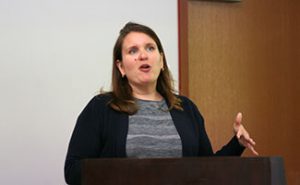Richard Paige — The Ides of August, the vehicle for Wabash professors to share their creative and research efforts with colleagues across disciplines, brings out the best in our classroom leaders.
Witness two biology professors – Bradley Carlson and Heidi Walsh – who found different, and wildly successful, ways to engage students.
Entertaining the idea to search online museum databases to check the demographics of wildlife populations, Carlson thought of a project that might suit his Advanced Ecology students. Usually, his research centers on turtles, so he is attuned to sex ratios, how those differ among climates, and whether the ratios change over time.

“Why would I focus on one species when there are hundreds?” he realized. “I can’t do that. I don’t have the time.”
What he did have was students in his BIO 313 class who wanted to engage in real research, collect data, and use analytical tools. Work like this would allow the students to see the results, good or bad, play out in real time, unlike simply watching a presentation or reading a paper.
“They don’t see how we don’t know what is going to come of this at all,” Carlson said. “A lot of work has to go into what looks like a simple result. There are some simple figures there, but each of the students knows that they had to put in hours in curating this data. They got to see the whole process.”
Each of the students contributed something to the finished product, and three of them – Christian Gosser ’20, William Robinson ’19, and Charles Mettler ’18 – wanted to pursue it further. The resulting paper, “Reptile Sex Ratios in Museum Collections are Associated With Climate Change and Phylogeny,” was presented by Carlson and colleagues from Yale and Berkeley at the Joint Meeting of Ichthyologists and Herpetologists this summer.
“It was a fun project to do and we all benefit from it,” Carlson said.
For Walsh, it would require an almost superhuman effort for her Organismal Physiology students to teach concepts to middle schoolers. Well, maybe superhero is more like it.

Walsh and her students used superhero attributes – imagine flying like Superman, having the strength of Thor, or the lightning-quick reflexes of Wonder Woman – to force her students to think about the concepts differently. About a month of lab work is dedicated to the project where students build lesson plans that explain concepts, set up experiments, and collect and graph data all through the prism of superheroes.
“It was really cool to see them work through showing concepts in a hands-on way to kids of this age group,” Walsh said. “They had a lot of fun with it, so it was rewarding. The best part is that they are amazingly creative with how they illustrate these things.”
Imagine using different sized tubes to represent blood flow or using a Nerf gun to facilitate an experiment in reaction time. According to Walsh, one memorable teaching aid required creating Thor’s Hammer with a five-gallon bucket, some quick-dry cement, and a squeeze ball attached to the handle to measure how much force was applied when the kids tried to lift it.
“Our students just light up, not just when designing activities, but in interacting with the kids,” she said. “They are really, really good. They’ve never done this before, and they don’t know how good they could be until they do it.”